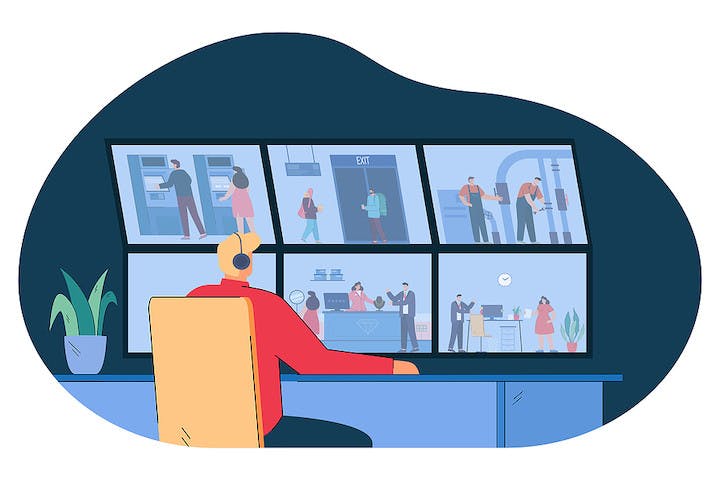Each day (or so it feels), I see all the major online news outlets carrying lengthy stories about the work-from-home culture.
It’s the new cause-célèbre: less depressing than the Covid-19 stories of the past two years, and still with some top-of-the-fold shelf life to go.
Many of these articles tend to present a cautionary tale about why working from home would be bad for a person’s career. They often present arguments around a lack of opportunities for interaction, reduced face time with the boss, and no chances for spontaneous creativity. For these reasons alone, some – such as JPMorgan CEO, Jamie Dimon – are resisting staff working from home.
But what if the reasons for such worries about employees’ welfare were instead due to a feature of remote technology that no one anticipated: the gaping void of supervision?
Managers like to see…
As a manager, there’s great comfort in being able to walk the halls and see people working; from knowing that deadlines and outcomes they are personally responsible for are being attended to and that if a problem arises, they will be there to save the day. For some managers this is a significant source of pride. So it stands to reason, that if people choose to work from home, how will they know if they’re actually working? How will they know if team members are all rowing in the same direction toward the looming deadline?
The fear of ‘not knowing’ was why progress bars were invented – you know, those little bars that creep across a scale to show you how far along you are in uploading a large file, or how much time is left for reading an online article. That’s why delivery companies like Amazon, FedEx, and the postal service offer tracking numbers. Because when you can see how far along your package delivery has come, you can temper your impatience against hard facts. When you don’t know where a thing is along a timeline of expectation, your innate fear of the unknown will cause you stress and anxiety.
So how does this fit into work I hear you ask?
Well, possibly, it’s that you don’t actually need progress bars!
By and large, people who work for a living tend to take pride in their abilities and are actively focused on the parallel successes of their career and their employer. In fact, many of the complaints that employees have shared with me in my 20-plus years of consulting come not from the subject matter of their work, but from the procedural roadblocks that stand in the way of getting things done. These come in the form of emails, meetings, and impromptu changes often delivered by the manager.
…but managers also need to chill out
The pandemic-induced crash course in using video chat technology demonstrated that employees could actually get their work done from their home office or kitchen table. This didn’t just include hands-on-keyboard work, but the meetings too! Yes, although first generation video chats were a bit cumbersome, awkward, and fatiguing, they proved, in practice, that everything people could do in an office could be done online.
It’s true that working from home and only interacting with colleagues during scheduled meetings isn’t always as beneficial as being part of the three dimensional culture of the office. That’s because meetings are only one part of work life. Experts have noted the potential for face time bias among managers and co-workers in favor of those who continue to come to the office. It makes sense; if you’re used to a real-world workplace, you’ll likely be more attracted to those who occupy that same real space.
But pandemic-era Zoom meetings were merely a lift-and-shift of existing office culture. They converted a boring meeting in a conference room to a boring meeting on a computer screen. Every technology requires time to morph into its own maturity.
Time to think differently
While CEOs and managers rail against the impracticality of remote work, they do so based on a rearward projection — assessing new technologies against how we’ve always done it. It’s like dismissing outright the idea of landing a rocket back down on its tail. “Rockets go up, not down,” one might say. “It would be a waste of time to design otherwise.”
The new workplace actually has many ways of doing things better, with asynchronous technologies like Slack replacing daily commutes and back-to-back meetings, while simultaneously leveling the playing field for people for whom location, economic circumstance, linguistic ability, or other attributes once precluded their ability to pursue their desired career. Always-on virtual environments like Toucan.Events and KosyOffice provide opportunities for managers and employees to interact and co-exist informally, moment-by-moment, allowing them the comfort of knowing things are moving along, even between meetings.
So, for every old-school Wall Street CEO who says, “You can’t build a career by only coming into the office one day a week,” there are new era managers like Dan Price of Gravity Payments, who say you can.
Many good and great managers out there may not have realized just how much the pressures of their own jobs have shifted their focus from “leading people” to “maintaining a process,” eclipsing their true mission of helping people work together. It’s certainly a legitimate cause of fear for them, but one that can be easily resolved.
